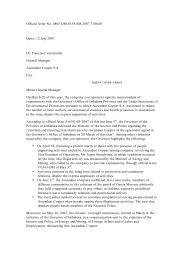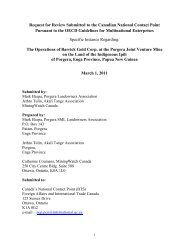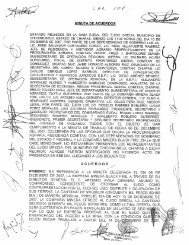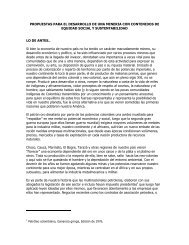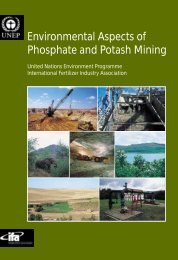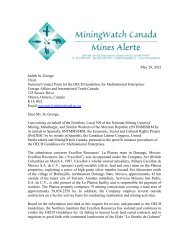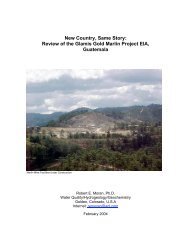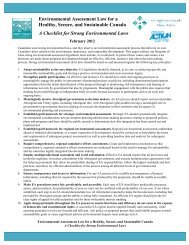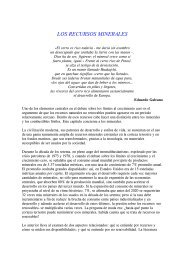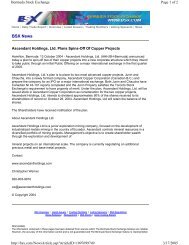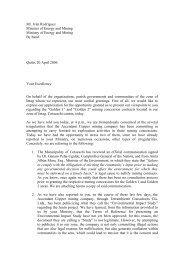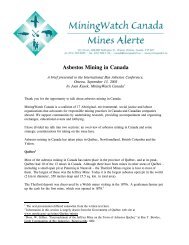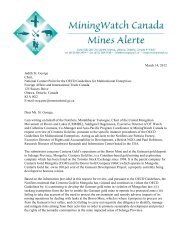Mining in Remote Areas Issues and Impacts - MiningWatch Canada
Mining in Remote Areas Issues and Impacts - MiningWatch Canada
Mining in Remote Areas Issues and Impacts - MiningWatch Canada
You also want an ePaper? Increase the reach of your titles
YUMPU automatically turns print PDFs into web optimized ePapers that Google loves.
In 1966, the Mt. Wash<strong>in</strong>gtonM<strong>in</strong>e on Vancouver Isl<strong>and</strong> went <strong>in</strong>toreceivership after only two years ofoperation. Yet it left a leg acy of acidm<strong>in</strong>e dra<strong>in</strong>age <strong>and</strong> heavy metal pollutionthat cont<strong>in</strong>ues to flow untreated<strong>in</strong>to the Tsolum River. Theconcentration of copper, particularlyharmful to young salmon, has all butwiped out the once healthy salmonruns. It has been estimated that theloss of the salmon fishery costsnearby communities $2 million ayear. To date, the prov<strong>in</strong>ce has already<strong>in</strong>vested $1 million <strong>in</strong> its attemptsto deal with the problem. Themost probable means of controll<strong>in</strong>gthe AMD will cost taxpayers at leastan additional $6 million.(27)At Equity Silver m<strong>in</strong>e <strong>in</strong> northernBC there is presently a system <strong>in</strong>place that treats the acid m<strong>in</strong>edra<strong>in</strong>age that cont<strong>in</strong>ues to flow fromthe m<strong>in</strong>e. If the treatment systemwere to fail for an extended period oftime, the AMD would cause the poison<strong>in</strong>g<strong>and</strong> eventual loss of all fish asfar as 215 km downstream. The resultantpotential loss of economicbenefits <strong>and</strong> employment from commercial<strong>and</strong> sports fisheries is estimatedto be <strong>in</strong> the range of $4.3 millionper year.(28,44).Negative impacts on humanhealth may result from m<strong>in</strong><strong>in</strong>g operations,but it is difficult to attach adollar figure to those impacts.As Lloyd Tataryn writes, “the Indians<strong>in</strong> the NWT have not been theprimary beneficiaries of the arseniccontam<strong>in</strong>at<strong>in</strong>g<strong>in</strong>dustries located <strong>in</strong>Yellowknife. We feel it is unjust thatcompanies can make profits fromjeopardiz<strong>in</strong>g the health of the peoplewho have lived on the l<strong>and</strong> s<strong>in</strong>cetime immemorial.”(45)Community health impacts relatedto m<strong>in</strong><strong>in</strong>g are addressed <strong>in</strong>more detail <strong>in</strong> the next section of thiskit: Health <strong>and</strong> Safety.Social <strong>and</strong> Cultural<strong>Impacts</strong>The social <strong>and</strong> cultural implicationsof m<strong>in</strong><strong>in</strong>g developments are oftenbrushed under the rug <strong>in</strong> orderCase Study: Need for Targetted Tra<strong>in</strong><strong>in</strong>gIn 1995, Falconbridge signed an “historic” agreement with the Inuit <strong>in</strong> northern Quebec.Among other th<strong>in</strong>gs, the company agreed to provide at least 150 jobs <strong>and</strong> tra<strong>in</strong><strong>in</strong>gfor the Inuit people at their Raglan nickel m<strong>in</strong>e.(40)The company orig<strong>in</strong>ally thought that with<strong>in</strong> 10 years Inuit could comprise 90% ofthe workforce. However, three years after the agreement was signed, <strong>and</strong> afterspend<strong>in</strong>g $4 million on tra<strong>in</strong><strong>in</strong>g, less than 25% of the workers are Inuit, (42) <strong>and</strong> thepercentage of Inuit employees at Raglan is not likely to rise <strong>in</strong> the next couple ofyears.To date, the tra<strong>in</strong><strong>in</strong>g has concentrated on prepar<strong>in</strong>g workers for jobs as cooks,heavy equipment operators, mechanics <strong>and</strong> truck drivers. With the constructionphase over <strong>and</strong> production gear<strong>in</strong>g up, there will not be many more jobs available tothe Inuit until they tra<strong>in</strong> <strong>and</strong> qualify for jobs <strong>in</strong> the mill or underground.“We should . . . make greater efforts to ensure that we target the occupations withthe greatest potential for employment,” said Jim Delaruier, Kativik School Board’s directorof vocational <strong>and</strong> adult education.And that’s what the Raglan Technical Committee on employment <strong>and</strong> tra<strong>in</strong><strong>in</strong>g hasdecided to do. At the heart of their new strategy is a college-level program <strong>in</strong> m<strong>in</strong><strong>in</strong>g,as well as on-the-job tra<strong>in</strong><strong>in</strong>g at the m<strong>in</strong>e.(42)Community<strong>Impacts</strong>800 jobs, <strong>and</strong> they will have a large role<strong>in</strong> evaluation of the project's environmentalimpact.Neither boom nor bust:41the renewable resourceeconomy may be thebest long-term hope for nort h-ern communities (Alternatives,v.22(4), Oct/Nov. 1996, p. 18)Author Heather Myers, assistant professor<strong>in</strong> International Studies at theUniversity of Northern BC, argues thatnon-renewable resource <strong>in</strong>dustries havenot ensured adequate or stable employment,either for northern peoples or forimported workers. Furthermore, theyounger generation has not shown aclear preference for mov<strong>in</strong>g from thel<strong>and</strong> <strong>in</strong>to <strong>in</strong>dustry. In the pursuit ofappropriate northern development, renewableresources can offer the potentialfor <strong>in</strong>come, while complement<strong>in</strong>gcommunity lifestyles <strong>and</strong> values. Theycan be locally based, small-scale, flexible,renewable <strong>and</strong> true to <strong>in</strong>digenoustradition. While they will not provide atotal answer to northern development,employment or <strong>in</strong>come needs, renewableresource-based ventures will satisfysome key needs <strong>and</strong> values.Tra<strong>in</strong><strong>in</strong>g of Inuit stepped42up at Raglan m<strong>in</strong>e(Nunatsiaq News, 04/23/98;http://www.nunatsiaq.com/nunavik/)Initial tra<strong>in</strong><strong>in</strong>g concentrated on prepar<strong>in</strong>gworkers for jobs as cooks, heavyequipment operators, mechanics <strong>and</strong>truck drivers. Now that that constructionphase is over <strong>and</strong> production isgear<strong>in</strong>g up, the m<strong>in</strong>e needs workers toexcavate <strong>and</strong> process the nickel ore;these are specialized trades that requireadditional tra<strong>in</strong><strong>in</strong>g.Turnover last year at Raglan reached70 percent.The Nasty Game: how43 environmental assessmentis fail<strong>in</strong>g aborig<strong>in</strong>alcommunities <strong>in</strong> <strong>Canada</strong>’s north(Alternatives, 22(4), Oct/Nov, 1996.p. 12)This article is written by Susan Wismer,assistant professor <strong>in</strong> the Departmentof Environment <strong>and</strong> ResourceStudies at the University of Waterloo.In the article, Wismer writes that Env i-ronmental Assessment (EA) can <strong>and</strong>should be an excellent process for determ<strong>in</strong><strong>in</strong>gwhether or not the outcomes<strong>M<strong>in</strong><strong>in</strong>g</strong> In <strong>Remote</strong> <strong>Areas</strong>: <strong>Issues</strong> <strong>and</strong> <strong>Impacts</strong> 13



